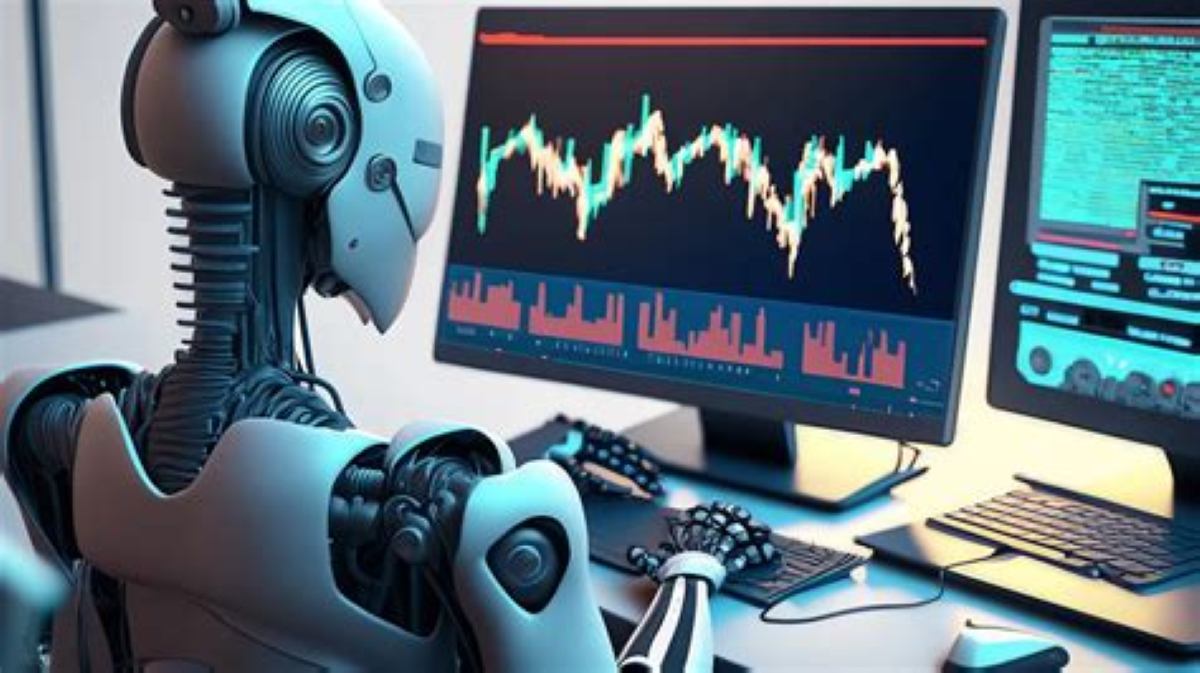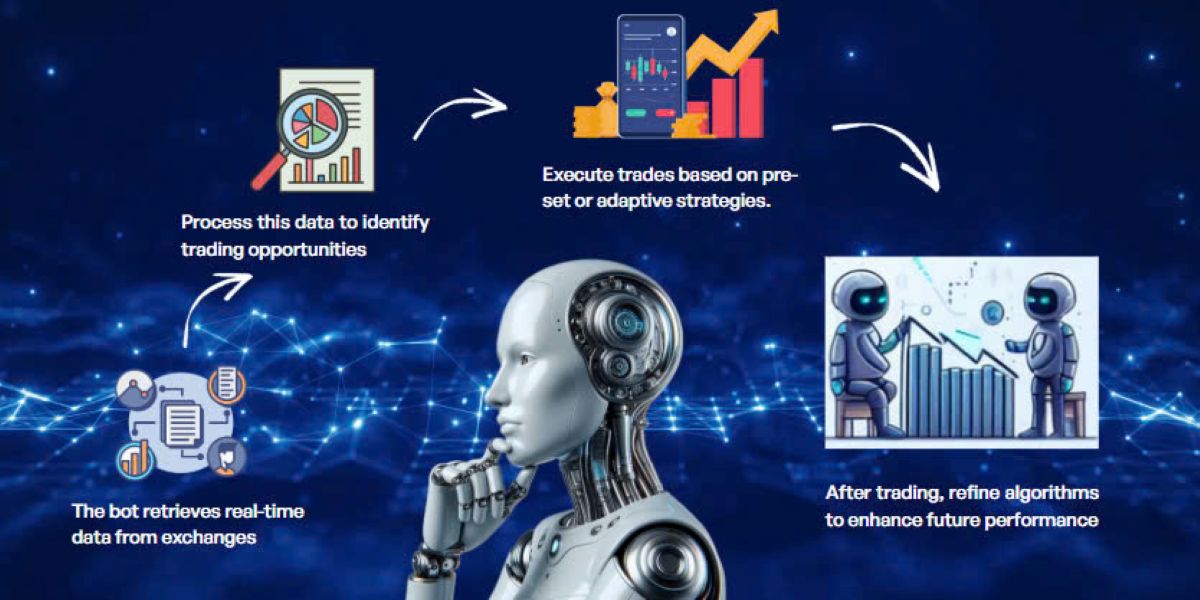AI powered trading bots are becoming increasingly popular among investors due to their ability to automate trades, analyze data rapidly, and make decisions free from emotional bias. They offer numerous benefits, such as optimizing performance, enabling 24/7 trading, and eliminating human psychological factors. However, alongside their profit potential, these bots also come with risks, including algorithmic errors, unpredictable market fluctuations, and cybersecurity threats. So how can traders maximize the benefits while minimizing the risks of using AI trading bots? Let’s explore the details in the article below.
Contents
What Are AI Powered Trading Bots?
AI Powered Trading Bots are automated trading software that leverage artificial intelligence (AI) to analyze markets, identify investment opportunities, and execute trades. Unlike traditional trading bots that follow fixed rules, AI Trading Bots can self-learn from market data to optimize trading strategies.
These bots are widely used across various financial markets, including stocks, forex, cryptocurrencies, and commodities. From individual traders to large institutions, many rely on AI Trading Bots to enhance investment performance, minimize errors, and eliminate emotional decision-making in trading.

How Do AI Powered Trading Bots Work?
Market Data Collection
Before making trading decisions, the bot must gather a large amount of real-time market data. It retrieves information from exchanges, including prices, trading volumes, financial news, and even market sentiment data from social media or investment forums. This data is processed quickly to ensure the bot has a comprehensive view of the current market conditions.
Analysis and Identification of Trading Opportunities
Once the data is collected, AI utilizes complex algorithms to analyze and identify potential trading opportunities. Machine learning models help the bot recognize trends, price patterns, and possible reversals. Some advanced bots even use natural language processing (NLP) to analyze financial news and assess its impact on the market.
Trade Execution
Based on the analysis, the bot executes trades following predefined strategies or adapts them to optimize performance.
Depending on the type of bot, trades can be executed in different styles:
- Scalping: Frequent trades within short time frames to capture small but numerous profits.
- Day Trading: Buying and selling within the same day to take advantage of short-term price movements.
- Swing Trading: Trading based on medium-term trends, holding positions for several days to weeks.
The bot’s execution speed is significantly faster than human traders, allowing it to capitalize on opportunities that manual traders might miss.
Learning and Optimization
After executing a trade, the bot does not stop there. It continues to assess its performance by analyzing the executed trade, comparing it with initial predictions, and adjusting its algorithms if necessary.
This process enables the bot to become more intelligent over time, improving its ability to predict market trends and increasing its success rate in future trades.
For example, if the bot identifies a trading pattern that consistently results in losses, it can automatically discard or refine its analysis criteria. This adaptability helps the bot adjust to market fluctuations and maintain optimal trading performance.

Benefits of AI Powered Trading Bots
24/7 Automated Trading with Unwavering Logic
One of the greatest advantages of AI Trading Bots is their ability to operate around the clock. Humans cannot monitor markets 24/7 without fatigue or stress, but AI excels at this task.
Financial markets, especially cryptocurrencies, can experience significant volatility at any time-even overnight or during holidays. Without constant monitoring, traders may miss opportunities or face unfavorable shifts. AI Trading Bots address this by continuously tracking markets and making instant decisions.
Moreover, human traders often fall prey to emotions like fear, greed, or herd mentality, leading to poor decisions. AI Trading Bots eliminate emotions entirely, ensuring disciplined and logical trades.
Fast and Accurate Responses
Financial markets move at lightning speed, especially during major news events. A delay of just a few seconds can result in missed profits or significant losses.
AI Trading Bots process millions of data points per second and execute trades almost instantly. For instance, when critical economic news breaks, a bot can analyze its impact and place trades before most human traders react.
Additionally, AI Trading Bots can handle multiple trades across different markets simultaneously-a feat humans struggle to achieve-maximizing profit opportunities from various sources.
Reduced Human Error
Even seasoned traders can make mistakes, such as entering wrong orders, forgetting stop-losses, or making impulsive decisions under pressure. AI Trading Bots eliminate these risks by sticking to pre-programmed rules.
For example, if a bot is set to cut losses at 5%, it will always follow through, unlike humans who might delay in hopes of a recovery. This ensures disciplined trading and limits losses.
Furthermore, AI Trading Bots continuously refine their strategies by learning from market data, something humans cannot match in speed or precision.
Risks of AI Powered Trading Bots
AI Isn’t Always Accurate
While AI Trading Bots outperform humans in data analysis, they aren’t infallible. Financial markets don’t always follow mathematical models, especially during unexpected events.
For instance, a financial crisis, a major political decision, or sudden news can trigger unpredictable volatility that AI fails to anticipate. If a bot isn’t programmed to handle such scenarios, it may execute flawed trades, leading to significant losses.
Additionally, some bots may be over-optimized (overfitted) to historical data, performing well in past conditions but struggling when markets shift-a key limitation traders must consider.
Hacking and Manipulation Risks
AI Trading Bots often connect to exchanges via APIs, making them attractive targets for hackers. If compromised, a bot could be manipulated to execute unwanted trades, causing substantial losses.
Moreover, markets-especially cryptocurrencies-can be influenced by “whales” (large investors) who create fake price movements to trick bots into poor trades, leaving smaller investors at a disadvantage.
To mitigate these risks, traders should choose reputable bot providers, enable two-factor authentication (2FA), and limit the bot’s access to their trading accounts.
High Usage Costs
AI Trading Bots aren’t cheap. High-performance bots often require monthly subscription fees or profit commissions. Additionally, efficient bot operation demands powerful servers, stable internet, and sometimes premium market data to boost AI accuracy.
For traders with limited capital, these costs can outweigh profits, making AI Trading Bots a financial burden rather than a benefit.
Are AI Trading Bots the Perfect Solution?
AI Powered Trading Bots bring a wealth of benefits to the table, including lightning-fast execution, pinpoint accuracy, and the ability to trade without emotional interference. They excel at processing vast datasets and adapting to market shifts, offering traders an edge in efficiency and discipline. However, they are not without flaws. Risks such as unpredictable market behavior, potential inaccuracies in AI predictions, security vulnerabilities like hacking, and steep operational costs pose significant challenges.
To maximize their potential, traders must grasp how these bots function, choose reliable providers, and maintain a cautious approach rather than depending solely on automation. Ultimately, while AI Trading Bots can significantly enhance trading performance, they fall short of perfection. Human oversight remains critical to navigate the complexities of real-world markets, ensuring strategies stay aligned with dynamic conditions and unexpected events.
Ready to master AI Powered Trading Bots and boost your trading success? Follow Best Sniper Bots for the latest insights, expert tips, and strategies to leverage AI in the market.
